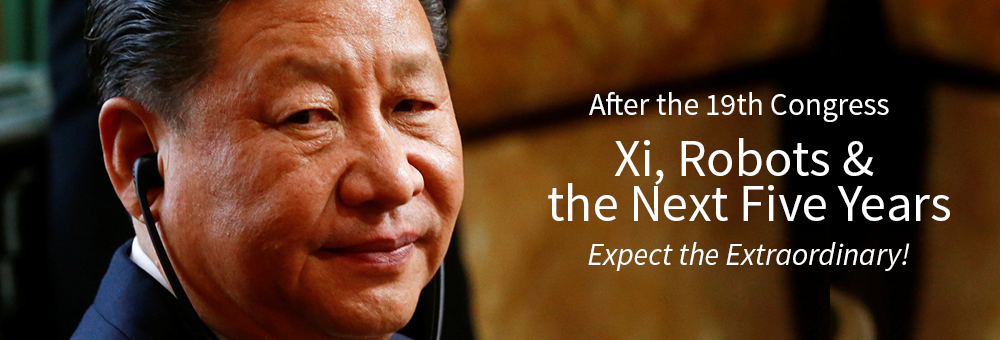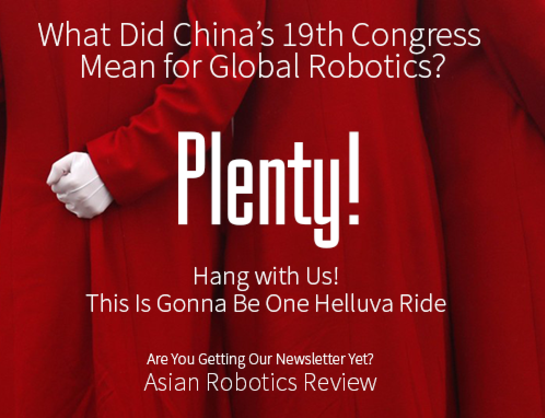
Opportunities for Robotics in Asia Totally Unprecedented
Everything is in play for the next five years...at least
The Economist calls him the most powerful man in the world. Everyone else is probably just amazed at how Xi Jinping has come so far so fast. Wasn’t it only March of 2013 that he became President Xi Jinping? Extraordinary is as good a word as any to describe the man and all that he’s accomplished in five short years.
The essential robot
One thing for sure about Xi is his belief in robots as bedrock to the success of his country. In a speech before the Chinese Academy of Sciences in 2014, he called for a “robot revolution” that would transform China, and then the world: “Our country will be the biggest market for robots, but can our technology and manufacturing capacity cope with the competition? Not only do we need to upgrade our robots, we also need to capture markets in many places.”
When was it that any leader anywhere said anything akin to that about any machine? And he called them by name, robots. True to his word, China became the globe’s biggest buyer of robots as well as the most vocal advocate of their place in the country’s future success.

At the recently concluded 19th People’s Congress, Xi opened with a three-hour, 66-page speech in which he reiterated his faith in technology and China’s need to make it an even greater resource.
For four years now, Xi has had the advantage of seeing firsthand how technology has impacted his country for the better. He’s watched the robots march in. He’s a believer. About halfway through his marathon speech, he lit out into innovation:
“Innovation is the primary driving force behind development; it is the strategic underpinning for building a modernized economy. We should aim for the frontiers of science and technology, strengthen basic research, and make major breakthroughs in pioneering basic research and groundbreaking and original innovations. We will strengthen basic research in applied sciences, launch major national science and technology projects, and prioritize innovation in key generic technologies, cutting-edge frontier technologies, modern engineering technologies, and disruptive technologies.”
Since 2013, Xi backs what he believes in with money, energy and zeal. It seems never to be hollow rhetoric, which is refreshing in comparison to the meaningless chatter from many others on the world stage. What he told the audience at the Chinese Academy of Sciences in 2014 he followed through on; what he promised the 19th People’s Congress will undoubtedly receive equal effort.
And he puts numbers to it all, as he did at Davos in January: “In the coming five years, China is expected to import $8 trillion of goods, attract $600 billion of foreign investment and make $750 billion of outbound investment.”
Again, that’s $8 trillion in imports over five years! That’s an amazing number. That means boatloads more of robots, robot parts, and automation tech like 3D printers and CNC machines, with piles of artificial intelligence (AI) larded over everything.
See our Blast Off article series:Getting Ready for 2018. Six related articles on scene-setting and trends for robot-driven automation in China and greater Asia.
Five years on
In five years at the 20th People’s Congress, President Xi will probably announce to his audience that his ten-year term wasn’t enough, that he needs more time. It will come as a surprise to no one.
What’s obvious is that the next five years will be pressure filled for Xi to make good on his promise of the China Dream and that another term in office at the country’s helm is more of than a good thing for the Chinese people.
The net-net for robotics it would seem is just as obvious.
For startups, seasoned manufacturers, parts suppliers, SW developers, factory automation integrators, AI designers, and just about anyone in the robotics ecosystem, China will remain wide open for business for the next five years…at the very least!
The opportunities for robotics in Asia are totally unprecedented. In short, robotics has never had it so good.
Across the Sea of Japan
The best barometer for future robot sales is Japan.
For the global robot industry, especially from Japan, China is buying as much as it possibly can. Japan’s robot shipments surged in third quarter with robust demand from China. “Chinese contract manufacturers of smartphones and other manufacturing-sector companies continue to tap Japanese industrial robots for help with assembly. Shipments of industrial robots from Japan Robot Association members reached $1.72 billion in the July-September quarter, up 39.9 percent on the year.”
FANUC, for example, reports the Nikkei Asian Review: “Thanks largely to rising demand in China, Japanese robot maker Fanuc is on a steady growth path, expecting a 36.5 percent rise in group operating profit in the current fiscal year through March, to $1.83 billion from a year before.”
Like most Japanese robot manufacturers, FANUC’s Chairman and CEO Yoshiharu Inaba is ecstatic with the landslide in sales from China: “Production is at full capacity so sales are capped. We can’t make any more,” said Inaba.
Such has been the situation in robot sales and critical parts crossing the Sea of Japan since April: see: We’ve Got Liftoff…Finally!The first half year (1H2017) witnessed buckets of joyous black ink beginning to cascade over corporate balance sheets. Board rooms that were formerly places for long faces and hand-wringing uncertainty, suddenly changed to broad grins and fist bumps.
Welcome to 2018
Asian Robotics Review has put together a comprehensive look at what’s ahead for Asian robotics in 2018. We call it, Welcome to 2018. A few of the in-depth, hot topics from that report:
- Forecast for Industrial Robots Through 2020
- New Automation, New Attitude, New Asia
- Asia Spending Big and Fast for Technological Advantage Is Making Headway
- Robot Parts: Critical Importance Amid Explosive Growth
- Will Cobots & Augmented Reality (AR) Spike Productivity?
- AI Arrives in Asia: Let the Games Begin!


